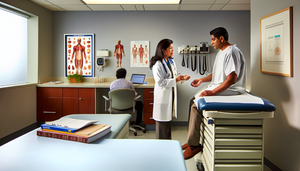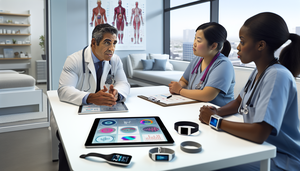
Advancements in Cardiology: Cutting-Edge Treatments and Innovative Interventional Procedures for Cardiovascular Event Prevention
Discover how advancements in cardiology are revolutionizing the treatment and prevention of cardiac events.
Read more
Shared Decision-Making: Empowering Patient Autonomy through Informed Consent and Education
Shared decision-making enhances healthcare by aligning choices with patient values and preferences.
Read more
Navigating Sensitive Topics: Effective Communication Techniques for Delivering Bad News in Clinical Practice
Learn to communicate bad news with clinical sensitivity to enhance the doctor-patient relationship.
Read more
Effective Doctor-Patient Communication: Building Empathy to Enhance Therapeutic Adherence
Effective communication and empathy enhance therapeutic adherence and improve patient health outcomes.
Read more
Learning from Errors: Clinical Cases of Diagnostic Failures and Continuous Improvement in Safety Culture
Explore how diagnostic failures drive continuous improvement through the review of clinical cases.
Read more
Utilizing Diagnostic Checklists: Enhancing Quality of Care and Patient Safety through Standardized Protocols and Screening Tools
Discover how diagnostic checklists enhance care quality and patient safety.
Read more
Diagnostic Errors and Cognitive Biases: Key Steps to Reduce Clinical Practice Failures through Case Analysis
Discover how to minimize diagnostic errors by addressing cognitive biases and enhancing patient safety.
Read more
Utilizing Epidemiological Data for Clinical Decision-Making: Insights from Statistical Analysis and Population Evidence
Discover how epidemiological data enhances clinical decision-making and optimizes health outcomes.
Read more
Addressing Health Inequalities: Perspectives on Equitable Care and Social Determinants in Health Policy
Explore how to tackle health inequalities through equitable care strategies and inclusive policies.
Read more
Healthcare Response to Epidemic Outbreaks: Lessons Learned and Contingency Plans for Effective Contact Tracing
Discover how innovation and prior experience enhance the containment of global epidemic outbreaks.
Read more
The Role of Diet in Managing Chronic Diseases: A Guide for Physicians on Therapeutic Nutrition and Metabolic Control
Discover how a well-planned diet can enhance the quality of life in chronic diseases.
Read more
Promoting Healthy Habits: Practical Tips for Implementing Lifestyle Changes in Your Practice for Disease Prevention through Nutrition and Exercise
Discover how to integrate effective nutrition and exercise strategies into medical consultations to prevent chronic diseases.
Read more
Identifying Nutritional Deficiencies: Clinical Signs and Comprehensive Dietary Assessment of Vitamins and Minerals
Early detection of nutritional deficiencies through comprehensive assessment prevents serious complications in patients.
Read more
Managing Postoperative Complications: Early Detection Strategies for Infection, Thrombosis, and Effective Rehabilitation
Explore effective strategies for the early detection and management of common postoperative complications.
Read more
Preoperative Assessment and Perioperative Management for High-Risk Surgery: Key Recommendations for Multidisciplinary Collaboration
Discover how multidisciplinary collaboration and prehabilitation optimize outcomes in high-risk surgeries.
Read more
New Horizons in Minimally Invasive Surgery: Technological Advancements and Patient Benefits with Surgical Robots, Laparoscopy, and Endoscopy
Discover how minimally invasive surgery, driven by technological advancements, enhances recovery and clinical outcomes.
Read more
Digital Health Tools: Enhancing Clinical Outcomes with Medical Applications and Monitoring Devices
Digital health tools are transforming clinical practice by significantly improving clinical outcomes.
Read more
Personalized Medicine and Pharmacogenomics: Advancing Targeted Therapies through Biomarkers and Precision Medicine
Discover how personalized medicine and pharmacogenomics are transforming medical treatments into more effective and safer therapies.
Read more
Telemedicine in Clinical Practice: Challenges and Benefits of Digital Tools for Patient Follow-Ups
Discover how telemedicine is transforming patient follow-up by addressing challenges and providing key benefits.
Read more
Occupational Health Programs: Enhancing Ergonomics and Reducing Workplace Risks
Ergonomic interventions and occupational health programs reduce musculoskeletal disorders and enhance workplace productivity.
Read more